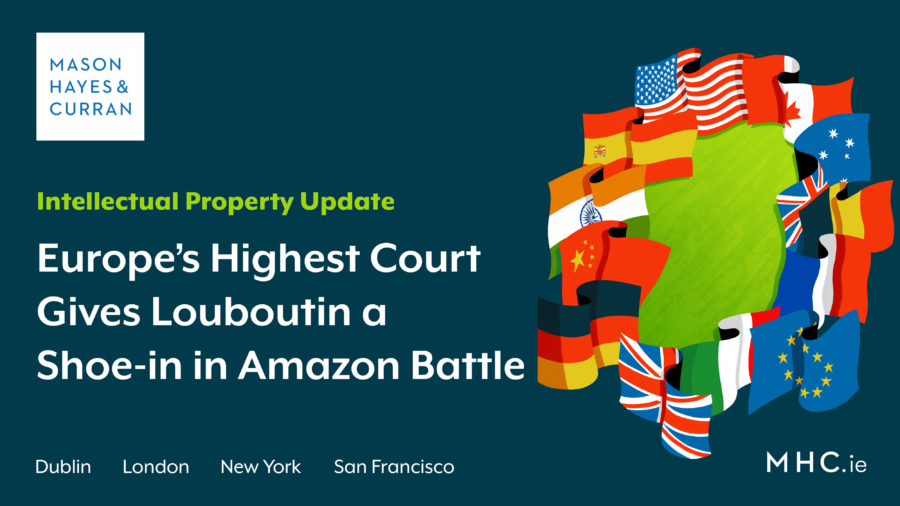
The Court of Justice of the European Union (CJEU) recently found that Amazon is facilitating the infringement of an EU trade mark on its marketplace by allowing a third party to advertise and sell its products on the platform. The brand at the centre of this dispute is the world-renowned red sole EU trade mark owned by Louboutin. Our Intellectual Property team examines how the EU court reached this conclusion.
The Court of Justice of the European Union (CJEU) found that the term “use” means that the operator of an online marketplace, such as Amazon, is itself using a sign where a third-party offers goods infringing an EU trade mark, on that marketplace. The EU trade mark in dispute is the world-renowned red sole owned by Louboutin. Mr Louboutin issued separate proceedings, grounded on Article 9(2)(a) Regulation 2017/1001[1], in Luxembourg & Belgium claiming infringement of Louboutin’s world-renowned red sole trade mark.
Article 9(2)(a) confers on the holder of an European Union Trade Mark (EUTM) the right to prevent all third parties from using, in the course of trade, a sign which is identical to its trade mark in connection with identical goods or services protected by the EU trade mark. So, how has the EU court concluded that Amazon could be held liable under EU trade mark law?
The concept of “use” in trade mark law
The central issue in this case is whether Amazon uses the Louboutin’s trade mark, and whether this use infringes the famous trade mark.
Use is not defined in the Regulation 2017/1001. At article 9(3) of the regulation, we are provided with a non-exhaustive list of uses that are prohibited, which includes:
- Affixing the sign to the goods or to the packaging of those goods
- Offering the goods, putting them on the market, or stocking them for those purposes under the sign, or offering or supplying services thereunder
- Importing or exporting the goods under the sign
What is “use” of a sign
It is well known that Amazon is an online marketplace that sells its own goods directly and offers third-party goods on its online marketplace platform. Mr Louboutin claimed that Amazon allowed third party display advertisements for counterfeit versions of Louboutin’s red-soled shoe to be presented on its marketplace without his consent and that this amounts to “use” by Amazon.
Mr Louboutin’s key arguments regarding use of a sign were that:
- The infringing advertisements form an integral part of Amazon’s commercial communication as the Amazon mark is displayed on each advertisement, and
- These advertisements resemble Amazon’s normal advertisements
In summary, the national courts asked the following questions of the CJEU on its interpretation of Article 9(2)(a) around the use of sign:
- How the alleged infringing advertisement is incorporated on a website by operators, whether the incorporation is strengthened by factors such as the fact that the advertisements are presented uniformly, and
- Whether use of a sign is attributable to the operator where the perception of a reasonably well-informed and observant internet user is that the operator played an active role in preparing the ad or it forms part of the operator’s own communications.
The CJEU acknowledged that the facts of the Coty Germany case involving Amazon as the defendant operator were different from the facts in dispute in this case. In the earlier case, Amazon was unaware that the goods at issue infringed a trade mark right, Amazon had not offered the goods at issue for sale or put them on the market. Whereas now Amazon do not just create the technical conditions necessary for use of a sign, Amazon play a more active role by assisting third-party sellers with marketing, and the storage and shipment of their goods.
What is a “commercial communication”?
On the interpretation of commercial communication, the CJEU confirmed that it is accepted that in order to establish whether the operator of an online marketplace does itself make use of a sign…it is necessary to assess whether a well-informed and reasonably observant user of that website establishes a link between that operator’s services and the sign in question.
Uniform advertisements
Noting the importance of the methods of presenting advertisements on these marketplaces, the CJEU emphasised the importance of transparency to enable relevant users to distinguish between offers from the operator and offers from third-party sellers. Where operators fail to distinguish its offerings from those of third-party sellers, and use uniform taglines, the CJEU held that relevant users are likely to think there is a link and that the goods being promoted are owned by the same operator.
Nature and scope of services
The court also noted that the relevant user would be influenced in thinking there was a link between the operator and third party where the service offered to third-party sellers included services such as shipping and management of returns.
Comment
This move by Louboutin to pin liability on Amazon makes sense. As noted by the Advocate General’s (AG) the online marketplace is constantly evolving and establishing liability of the intermediary rather than the elusive third-party may be more effective. Although notably the AG did not regard Amazon as using the trade mark in dispute.
The AG also pointed out that Amazon is not a traditional online marketplace, it is operating a hybrid model as a renowned distributor and a marketplace operator. The AG stated: “Amazon publishes on its online shop both advertisements relating to its own goods, which it sells and ships under its own name, and advertisements from third-party sellers. Its business practices also allow for the shipping of goods offered for sale by third-party sellers on its platform to be handled by those sellers or by Amazon, which stocks those products in its distribution centres and ships them to purchasers from its own premises.”
Now that the CJEU have given its preliminary ruling, it will be up to the national courts in Luxembourg & Belgium to determine whether Amazon has infringed Louboutin’s EU trade mark in light of the CJEU’s interpretation. This decision recognises the evolving online marketplace. Now Amazon and similar online operators will need to consider taking the necessary steps to distinguish their offerings to avoid further or any liability.
For more information on protecting your brand and related intellectual property rights, contact a member of our Intellectual Property team.
The content of this article is provided for information purposes only and does not constitute legal or other advice.
[1] Regulation (EU) 2017/1001 of the European Parliament and of the Council of 14 June 2017 on the European Union trade mark




